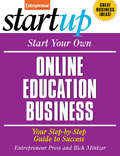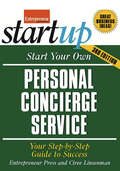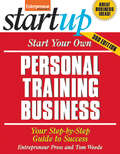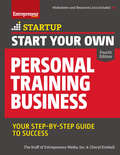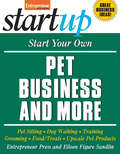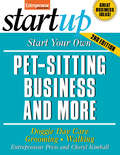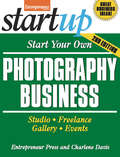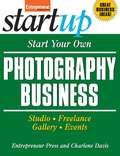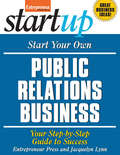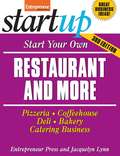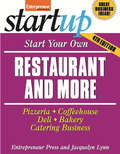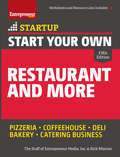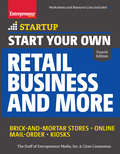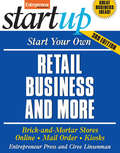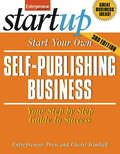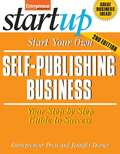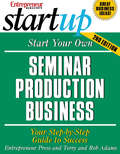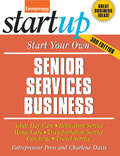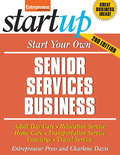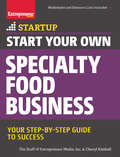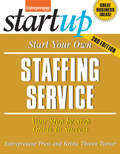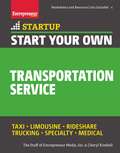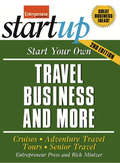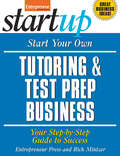- Table View
- List View
Start Your Own Online Coupon or Daily Deal Business
by Rich Mintzer Entrepreneur MagazineUnlike old-school "design your own coupon book" titles, this book moves straight into computer technology and proceeds to the latest trend in couponing . . . apps, which provide deals to mobile users in any location. Many daily deal businesses do not work to enhance the experience for their merchants. Readers, however, can learn how to do so. Experts in the industry are also included such as Marc Horne, co-creator of Daily Deal Builder, who discusses what it takes to build a daily deal site, David Teichner, CEO of Yowza!! who brought deal apps to iPhones and several business owners who have tried their luck at running daily deal. They discuss what they have learned from the process.Currently there are few, if any, other books on how to start a daily deal business and the coupon books focus on how to use coupons and even on extreme couponing, but not on running an online coupon business. This is a unique title which provides those who enjoy offering deals and discounts to get started in an industry that is still growing.
Start Your Own Online Education Business
by Entrepreneur PressOnline education is experiencing a huge growth spurt. The number of students taking online classes increased 24 percent in the past year-and this growth is only expected to continue. Don't let this lucrative opportunity pass you by. Take your teaching global by offering courses online. Learn everything you need to know to set up a successful online education business: Find financing, write a business plan, choose a business structure and learn other business basics Develop exciting courses in the four most popular areas-IT, health care, education and business-as well as niche markets Promote your business and attract students through online newsletters, search engine optimization and other innovative techniques Design a user-friendly website and provide high-quality tech support Train instructors in this new education medium, or teach courses yourself And more! Real-life stories from successful entrepreneurs show you exactly what you need to do to set up and run a profitable business. Now's the perfect time to get started with an online education business-and with this book, you're well on your way to success.
Start Your Own Personal Concierge Service
by Entrepreneur PressTurn Your Can-Do Attitude Into CashAre you a pro at multi-tasking? Do you thrive on deadlines and love a good challenge? Could you find satisfaction in lending others a hand? If so, you're in high demand in the booming personal concierge industry.Offering easy startup and low overhead, a personal concierge helps clients with everyday tasks from organizing to shopping. Led by our experts, learn how to successfully establish your business, develop your service list, build a client base, and even, expand. Plus, uncover the secrets of practicing entrepreneurs, gaining priceless insight, advice, and tricks on managing common and difficult requests.Learn how to:Make the right contacts to find great business and individual clientsIdentify and develop your service nicheChoose what services to offerSet fees and collect paymentBuild vendor relationshipsCost-effectively promote and advertise your serviceBuild loyalty and referrals among your clientsHire helpAnd moreSample forms, additional resources, checklists and work sheets guide you through every step of the startup process.You have what it takes to be an in-demand personal concierge-let us help you get started and succeed!
Start Your Own Personal Training Business
by Entrepreneur PressEarn a Healthy Living Helping Others Win the Battle of the BulgePersonal trainers aren't just for athletes and the rich and famous. With today's focus on the importance of living a healthy lifestyle, personal trainers are in high demand. You'll learn the nuts and bolts of starting a personal training business, including everything from establishing a business plan to getting certified to finding a profitable niche. Tips from successful trainers provide inspiration and advice along the way. They offer insights about:Requirements and startup costsWhat to expect during day-to-day operationsHow to stand out from the competitionUsing social media to build brand awarenessImplementing powerful marketing plansHow to hireBuilding solid relationships with clientsHow to track and manage financesThe most popular services trainers are offeringNew ways to link to the spirituality marketYou'll also find out about the latest trends in health and wellness so you can keep your business at the cutting edge in this rapidly expanding market. Whether you want to run a solo-operation or an exercise studio employing other trainers - you'll have the tools to succeed.
Start Your Own Personal Training Business: Your Step-by-Step Guide to Success
by Cheryl Kimball The Staff of Entrepreneur MediaPersonal training is an exciting industry to be in right now! Starting a personal training business can offer a satisfying combination of financial reward, a flexible schedule, and a career where you can make a profound difference in the lives of others.As skilled personal trainer, having good business knowledge and judgment can be the first step to earning a substantial income. In this revised guide, our experts teach you the nuts and bolts of starting a business, including everything from writing a business plan to finding a profitable niche. From boutique studios to partnerships with schools and private trainers, this book will help get you started on the right foot.
Start Your Own Pet Business and More
by Entrepreneur PressAre you a pet lover? Fascinated by all things furred, feathered and finned? Why not turn your passion for pets into a profitable business! A fast-growing market, the multibillion-dollar pet industry offers a world of business opportunities for entrepreneurs like you! From hands-on pet care to specialty pet products like toys, food, and treats, Entrepreneur covers the cat's meow of pet-related businesses. Providing insider advice, tips, and tricks along the way, our experts take you step by step and show you how to discover your specialty, legally and financially establish your business, manage day-to-day operations, and so much more! Choose from five hot areas of interest-pet sitting/dog walking, dog training, pet grooming, pet food/treats, upscale pet products Equip yourself with the right tools Set competitive fees Efficiently manage inventory and supplies for easy order fulfillment Use effective marketing and advertising tools to get the word out Build positive customer and vendor relationships Plan for future growth And more Let America's pampered pets help your profits- start your pet business today!
Start Your Own Pet-Sitting Business and More
by Entrepreneur PressAmericans love their pets. More than a quarter of all American households have dogs or cats. And then there are parrots and parrotfish, guinea pigs and pot-bellied pigs, iguanas and anacondas. If you love animals, you can start a profitable business caring for pets when their owners go on vacation. A pet-sitting business is easy to start and inexpensive to run. You can board pets in your home, visit pets in their homes, manage a staff of pet-sitters or even combine pet-sitting and house-sitting for greater profit. Plus, you can offer add-on services like grooming and walking. Learn everything you need to know to be a success, including: Tips on animal feeding, grooming and exercise Medical care information and resources Insurance, regulatory and legal liability issues What toys and supplies you need to make your job easier Startup basics like writing a business plan and managing your finances If you love animals, don't delay. Learn how to turn your passion into profit.
Start Your Own Photography Business
by Entrepreneur Press Charlene DavisPhotographers can turn a hobby into a lucrative business with these great tips on how to set up a studio, build a portfolio, take great pictures, purchase the best equipment, find paying jobs, set pricing and more. Davis also discusses the advantages of submitting work to contests, participating in art festivals and displaying work in art galleries and other locales. It covers both full-time and part-time options and discusses operating at home or in a commercial location. Detailed advice is offered on legal issues such as copyright infringement, privacy laws, the difference between public and private property, handling conflict and seeking out available remedies to legal situations.
Start Your Own Photography Business
by Entrepreneur PressIf you have a talent for snapping great pictures, why not turn your hobby into a lucrative business? You can take portraits in a studio or on location, submit photos as a freelancer to newspapers and magazines, frame and display your favorite shots in a gallery, or record special events like weddings and sweet sixteen parties. No matter where your talents and interests lie, you can make a bundle from your work with this expert advice. Learn how to: Set up a functional studio and build a portfolio Choose the right equipment for all types of photos-and find great deals on the cameras and accessories you need Find paying jobs and market yourself professionally Get great exposure for your work at art festivals, contests, galleries, local businesses and more Protect yourself from legal concerns such as copyright infringement and privacy issues Whether you want to earn a little extra money with a part-time business or set yourself up as a full-time, professional photographer, all the information you need to succeed is inside.
Start Your Own Public Relations Business
by Entrepreneur PressThe explosion of media opportunities and the rapidly changing communications landscape have served as key drivers for the public relations industry, creating huge opportunities for communications and PR specialists like you! Coaching you all the way, the experts at Entrepreneur show you how to parlay your PR experience into a successful new business. Our experts take you step by step from building the business foundation to managing day-to-day operations. Learn how to set up your firm, choose your market niche, prospect and sign clients, build media relationships, set fees, and more! Plus, gain priceless insight, tips, and techniques from practicing entrepreneurs and industry experts! Learn how to: Set up your own PR firm Choose your market niche Win over, sign, and keep clients Build strong, well-planned campaigns using the latest tools of the trade Develop prosperous relationships and partnerships Boost profits by expanding your business And more Go from public relations pro to CEO! Start your own public relations firm today!
Start Your Own Restaurant and More
by Entrepreneur PressAmericans spend nearly $600 billion a year eating out. As consumers are dining out or taking prepared food home with increased frequency, food-service operations are skyrocketing. There's plenty of room for more food businesses, but for a successful startup you need more than just good recipes. You also need to know about planning, capitalization, inventory control, and payroll management. Here's everything you need to consider when starting your own restaurant, pizzeria, coffeehouse, delicatessen, bakery, or catering business. Interviews with successful eatery owners show how others have made their food business dreams come true. Among the many topics covered are: Set-up and equipment Inventory Staffing Legal structure Location Permits Sanitation Marketing Financial management Fully updated with the newest trends in menu items, décor, and themes, plus recent market statistics and forecasts, this guide is your roadmap to success.
Start Your Own Restaurant and More
by Entrepreneur Press Jacquelyn LynnAmericans spend more than $600 billion a year eating out. Busy consumers don't have the time or inclination to cook - they want tasty, nutritious meals without dishes to wash. More and more singles, working parents and seniors are demanding greater convenience and are turning to restaurants to fill that need. There's plenty of room for more food businesses, but for a successful startup you need more than just good recipes. You also need to know about planning, capitalization, inventory control, and payroll management.Entrepreneur has compiled everything you need including how to evaluate the competition, how to research potential customers, the basics of setting up a kitchen, how to find a great location, how to leap over regulatory hurdles in the industry, and how to find the best people to staff your business. Among the many topics covered are:Set-up Staffing Permits MarketingEquipment InventoryLegal structureSanitationFinancial managementFully updated with the newest trends in menu items, décor and themes, plus recent market statistics and forecasts. Interviews with successful eatery owners show how others have made their food business dreams come true. So whether you decide to keep it simple with a sandwich-and-salad operation or make a splash with a four-star bistro, we've got the information you need to be a success.
Start Your Own Restaurant and More: Pizzeria, Coffeehouse, Deli, Bakery, Catering Business
by Rich Mintzer The Staff of Entrepreneur MediaShifting demographics and changing lifestyles are driving the surge in food-service businesses. Today's busy consumers don't have the time or the inclination to cook-they want tasty, nutritious meals without dishes to wash. More and more singles, working parents, and seniors are demanding greater convenience and are looking to restaurants and food services to fill that need.There's plenty of room for more food businesses, but for a successful startup you need more than just good recipes. You also need to know about planning, capitalization, inventory control, and payroll management. The staff of Entrepreneur has put together everything you need to know to start, run, and grow the successful restaurant or food service of your dreams.
Start Your Own Retail Business and More
by The Staff of Entrepreneur Media Ciree LinsenmannOPEN THE STORE OF YOUR DREAMS: START YOUR OWN RETAIL BUSINESSRetail is one of the fastest-growing-and fastest-changing-segments of the economy. Apps, pop-up shops, and online shopping have made it easier to reach, interact with, sell to, and gain loyal customers. Making this the perfect time for eager entrepreneurs, like you, to stop dreaming and start selling.Whether you're interested in opening a storefront, online shop, or portable kiosk, this detailed guide will help you decide if retail is right for you. Supported by practicing entrepreneurs and experts, you will understand what it takes to open a business, common mistakes to avoid, and how to keep your retail enterprise running successfully.Learn how to:Choose the right retail nicheSpot and capitalize on consumer trendsSelect merchandise that flies off the shelvesSet prices that maximize profitsPromote your business, products, and gain loyal customers using Pinterest, Facebook, and other social media and online marketing toolsHire a staff that will help you succeedPlus, gain priceless tips, tricks, and insight from successful retailers who share hard-wonadvice and cautionary notes.Everything you need to open and run your store is in your hands-get started today!
Start Your Own Retail Business and More
by Entrepreneur PressIn every community large and small, you're likely to see a variety of stores: clothing boutiques, gift shops, bookstores, specialty food shops, hardware stores. Their inventory may be totally different, but the steps involved in running them are much the same. Whether you want your own storefront, a kiosk in a mall, an e-commerce store or anything in between, this essential guide covers everything you need to know. Learn how to discover your niche, establish inventory, set pricing, create policies, reach customers, and more! Plus, gain priceless tips, tricks, and insight from successful retailers sharing hard-won advice and cautionary notes. Learn how to: Choose from popular retail niches-specialty items, clothing store, gift shop, kiosk, and more Discover the right sales avenue for your products Select merchandise that flies off the shelves Set prices to maximize profits Boost brand recognition using social media, public relations and other marketing strategies Efficiently manage inventory and supplies for easy order fulfillment Hire a staff that will help you succeed And more Retailing is a trillion-dollar industry-grab your share today!
Start Your Own Self Publishing Business
by Cheryl Kimball Entrepreneur PressProfits from PagesSelf-publishing is a fast-growing industry, and bookstores and consumers alike now acknowledge the value of self-published books. In this valuable guide, industry experts coach you in becoming a player in the self-publishing arena-whether it is self-publishing your own book or providing professional services for others who want to self-publish.Our experts reveal the tricks of the self-publishing trade: how to evaluate book ideas and recognize a hot-seller; how to develop an effective marketing plan; getting books reviewed and landing great publicity; getting books into traditional and non-traditional sales channels; tapping into the potential of online publishing, and more.Addresses dramatic game-changers including print-on-demand and ebooksReviews industry player offerings including Ingram and AmazonCovers critical marketing tools including author websites and social media marketingFeatures interviews with industry insiders and practicing self-published authorsPlus, a quick-reference guide to every step in the publishing process helps you along your way.
Start Your Own Self-Publishing Business
by Entrepreneur Press"I should write a book." If that thought has ever crossed your mind, there is no better time to start than now. New print technologies, print-on-demand publishing and better distribution channels have made it easier than ever for aspiring writers like you to write, edit and publish a book. You'll find out how to take your book from an idea to a finished product, with professional advice from industry insiders. Learn how to: Develop a grass-roots marketing plan Promote your book through book reviews and newspaper articles Find nontraditional places to sell your book Tap the potential of online publishing and print-on-demand Avoid common new-author mistakes Industry experts and successful self-publishers reveal their secret tips and tricks so you, too, can become a published author. Plus, a quick-reference guide to every step in the publishing process helps you along your way. Take the first step to becoming a published author today!
Start Your Own Seminar Production Business
by Entrepreneur PressDid you ever think you might be able to make money leading seminars to teach others what you know? Or promoting a dynamic speaker who motivates the crowds? Many people pay top dollar to attend seminars that teach them how to do something faster, better, more easily or more profitably-which gives you a great opportunity for profit. This hands-on guide, completely updated with the latest trends and newest information, details how to plan seminars, webinars, and teleseminars for yourself or someone else from start to finish. Learn how to: Negotiate for great deals on halls, hotels and conference rooms Promote a business with almost no cash investment Use ingenious PR tactics that will draw attendees-and profits-like a magnet Test-market your subject matter before spending a dime Develop and sell CDs, books and other profitable materials People who promote and produce seminars are making huge profits-and so can you! Get in on the action in this booming field today.
Start Your Own Senior Services Business
by Entrepreneur Press Charlene DavisThe senior population is multiplying by the millions! In fact, during the next 25 years, the senior population in America is expected to double - growing faster than the total population in every state. This means one thing: a tremendous opportunity for aspiring and compassionate entrepreneurs. From providing adult daycare or homecare to transportation or concierge needs, this guide covers today's most requested services within the 65-and-older market. Readers learn, step by step, how to choose the right opportunity for them, legally and financially establish their business, acquire licenses and certifications, set policies and procedures, and much more! Priceless insight, advice, and tips from practicing senior care professionals help aspiring entrepreneurs to discover their specialty from within one of six growing areas of interest - adult daycare, relocation services, homecare, transportation services, concierge, and travel service; design a business to suit customers' demographics and special needs; set rates; create a support staff who will facilitate success; use effective marketing and advertising to get the word out; build valuable business partnerships that lead to referrals; and plan for future growth. A record number of seniors are seeking help, and this guide is the key to starting a senior care service today!
Start Your Own Senior Services Business
by Entrepreneur PressThe senior population is multiplying by the millions! In fact, during the next 25 years, the senior population in America is expected to double-growing faster than the total population in every state. This means one thing-a tremendous opportunity for aspiring and compassionate entrepreneurs like you! From providing adult daycare or homecare to transportation or concierge needs, our experts cover today's most requested services within the 65+ market. Learn, step by step, how to choose the right opportunity for you, legally and financially establish your business, acquire licenses and certifications, set policies and procedures, and much more! Plus, gain priceless insight, advice, and tips from practicing senior care professionals. Learn how to: Discover your specialty within one of six growing areas of interest- adult daycare, relocation services, homecare, transportation services, concierge, and travel service Design your business to suit your customers' demographics and special needs Set your rates Create a support staff who will help you succeed Use effective marketing and advertising to get the word out Build valuable business partnerships that lead to referrals Plan for future growth A record number of seniors are seeking your help-start your senior care service today!
Start Your Own Specialty Food Business
by Cheryl Kimball The Staff of Entrepreneur MediaBring Your Fresh Ideas to Market and ProfitFueled by growing consumer demand for new tastes, cleaner ingredients, health benefits, and more convenient ways to shop and eat, the business of specialty food is taking off at full speed. This step-by-step guide arms entrepreneurial foodies like yourself with an industry overview, the hottest trends, important research and statistics, and insight from practicing specialty food business owners on key growth drivers, opportunities, and how you can differentiate from other food businesses.Discover how to:Find the right avenue for your specialty food business: home-based, retail shop, production, wholesale, or distributionCreate a solid business plan, get funded, and get the essential equipmentGet the right licenses, codes, permits, insurance for your operationsGain a competitive edge using market and product researchFind a profitable location, partnerships, and in-store shelf spacePromote your business, products, and services online and offlineAttract new and loyal customers using social media platforms like Instagram, Snapchat, and PinterestManage daily operations, costs, and employeesPlus, get valuable resource lists, sample business plans, checklists, and worksheets
Start Your Own Staffing Service
by Entrepreneur Magazine Krista TurnerThe new world economy is tough on job security. Hordes of skilled, experienced, motivated workers are flooding the market, looking for work. And lots of merged and downsized companies now outsource the work that used to be done by permanent employees. The bright side? It's prime time for the staffing profession.Detailing the hottest specialties in the staffing service industry-facilities staffing, industrial staffing, office/clerical staffing, temp staffing and temp-to-perm staffing-the experts at Entrepreneur provide everything eager entrepreneurs need to know to start their own staffing service.Covers:-Industry trends and opportunities-Identifying a specialty-How to establish the business-from securing licenses and financing to buying equipment and recruiting employees-Building a client base-Promoting and marketing the business-Managing day-to-day operations-Staying on top of financesEntrepreneurs also gain priceless insight from practicing entrepreneurs who reveal little-known tricks of the trade and common hazards to avoid. Aspiring business owners are given sample documents, worksheets, and other example materials to reference as they move their business forward. Specialties covered include: Facilities staffing-placing employees in long-term or indefinite-length assignments Industrial staffing-specializing in manual laborers, food handlers, cleaners, assemblers, drivers, tradespeople, machine operators, etc. Office/clerical staffing-focusing on secretaries, receptionists, administrative assistants, word processing and data-entry operators, etc. Temporary staffing-supplying client companies with workers on a short-term basis Temp-to-perm staffing-offering clients a convenient way to try out temporary workers for permanent positions
Start Your Own Transportation Service: Your Step-by-Step Guide to Success
by Cheryl Kimball The Staff of Entrepreneur MediaStart Your Own Transportation Service shows readers how to create a revenue stream by thinking outside the traditional transportation box. Features information on how to start businesses in the areas of ridesharing, executive car service, special events, medical transport, and pedicab/party services. The personal transportation business is the hottest trend in the service industry, offering riders an alternative to traditional taxi, bus, and shuttle services. The perfect business for the entrepreneur, a transportation service allows business owners to go as big or as small as their market allows, from a single-car rideshare service to a full-fleet operation with multiple drivers. Featuring Entrepreneur's trusted branding and strategies, this title gives readers the keys to success.
Start Your Own Travel Business
by Entrepreneur PressPack Your Bags...Full of Profits!At over a billion dollars, the travel industry is evolving, creating new trends and new opportunities for eager entrepreneurs like you. Our experts take you step-by-step as you embark on your most exciting adventure-starting a business. Discover success as an independent travel or specialty tour professional offering unique opportunities-in both geography and market niche-that even online discount travel sites can't compete with.From exotic getaways to adrenaline-pumping extreme tours and time-saving technology to important regulations, learn how to conduct business by land, air, or sea. Plus, access an abundance of resources including important associations, travel-specific software, mailing lists, and in-the-trenches tips from successful travel specialists and tour operators.Covers: Hot travel markets including: business, leisure, adventure, honeymoons, family, men only, women only, seniors, and more Designing and pricing your services and packages Managing your finances Using efficient software systems and mobile technology for daily operations Complying with security regulations for domestic and foreign travel Advertising and promoting online and in print Growing your businessFrom finding your clients to delivering a trip of a lifetime and everything in between, learn what you need to know to become a high-flying success!
Start Your Own Tutoring and Test Prep Business
by Entrepreneur PressAre you an advocate of higher education? Do you enjoy teaching others? Are you interested in starting a business that makes money and a positive impact? If so, then you'll earn high marks in the tutoring and test prep arena! Whether you want to start a one-on-one tutoring business from home, an online-based education support program, or manage your own learning facility, our experts cover everything you need to know. Learn business basics including how to choose your niche, secure financing, legally establish your business, manage day-to-day operations, and more. Gain an understanding of learning approaches, the latest teaching methods, industry technology and tools, and other industry essentials. Plus, round out your startup curriculum with invaluable advice and examples from current business owners! Learn how to: Match your skill set with your market and their needs Choose a business environment that works for you Master effective teaching methods for diverse learning approaches Write a marketing plan that captures clients and creates referrals Develop profitable academic relationships Create a support staff who will help you succeed Set your fees Boost profits by expanding your specialty or your business The need for education support is growing rapidly-grab your share of this billion dollar market!

